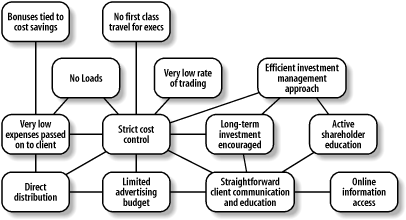Strategic Fit
Let’s draw an example from Porter’s On Competition to learn how to connect the dots between business strategy and information architecture. Porter uses “activity-system maps” as a tool for examining and strengthening strategic fit. Figure 18-2 shows an activity-system map for Vanguard, a leader in the mutual fund industry.

Figure 18-2. An activity-system map for Vanguard
As Porter explains, Vanguard is widely respected for providing services to the conservative, long-term investor, and the company’s brand is very different from that of competitors such as Fidelity and T. Rowe Price.
Vanguard strives for a strategic fit between all its activities, from limiting the costs of advertising and business travel to fostering shareholder education and online information access. Low costs and informed investors go hand in hand.
This strategy is no accident. As founder John C. Bogle explains, early in its history, Vanguard established “a mutual structure without precedent in the industry—a structure in which the funds would be operated solely in the best interests of their shareholders.”[59] Noting that “strategy follows structure,” he suggests that it logically followed to pursue “a high level of economy and efficiency; operating at bare-bones levels of cost, and negotiating contracts with external advisers and distributors at arms-length. For the less we spend, the higher ...
Get Information Architecture for the World Wide Web, Second Edition now with the O’Reilly learning platform.
O’Reilly members experience books, live events, courses curated by job role, and more from O’Reilly and nearly 200 top publishers.

